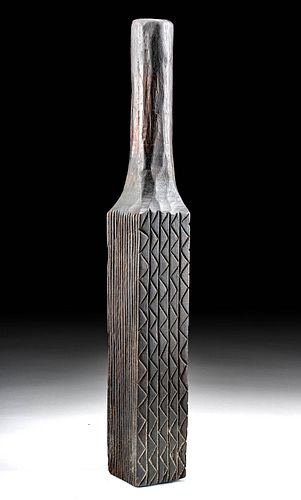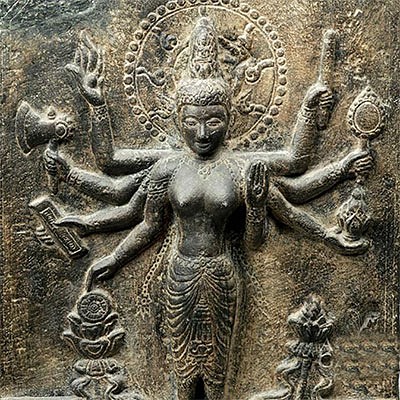20th C. Hawaiian Wood Tapa Beater
Lot 210
About Seller
Artemis Gallery
686 S Taylor Ave, Ste 106
Louisville, CO 80027
United States
Selling antiquities, ancient and ethnographic art online since 1993, Artemis Gallery specializes in Classical Antiquities (Egyptian, Greek, Roman, Near Eastern), Asian, Pre-Columbian, African / Tribal / Oceanographic art. Our extensive inventory includes pottery, stone, metal, wood, glass and textil...Read more
Categories
Estimate:
$700 - $1,000
Absentee vs Live bid
Two ways to bid:
- Leave a max absentee bid and the platform will bid on your behalf up to your maximum bid during the live auction.
- Bid live during the auction and your bids will be submitted real-time to the auctioneer.
Bid Increments
| Price | Bid Increment |
|---|---|
| $0 | $25 |
| $300 | $50 |
| $1,000 | $100 |
| $2,000 | $250 |
| $5,000 | $500 |
| $10,000 | $1,000 |
| $20,000 | $2,500 |
| $50,000 | $5,000 |
| $100,000 | $10,000 |
| $200,000 | $20,000 |
About Auction
By Artemis Gallery
Feb 4, 2021
Set Reminder
2021-02-04 10:00:00
2021-02-04 10:00:00
America/New_York
Bidsquare
Bidsquare : CLEARANCE Asian | Antiquities | Ethnographic
https://www.bidsquare.com/auctions/artemis-gallery/clearance-asian-antiquities-ethnographic-6361
Featuring discounted pricing on Asian art, classical antiquities from Egypt, Greece, Italy, and the Near East...plus Pre-Columbian, Tribal, Russian Icons, Spanish Colonial, Fine Art, more! Starting prices have been reduced up to 65% from original auction prices - perfect for dealers and collectors! Artemis Gallery info@artemisgallery.com
Featuring discounted pricing on Asian art, classical antiquities from Egypt, Greece, Italy, and the Near East...plus Pre-Columbian, Tribal, Russian Icons, Spanish Colonial, Fine Art, more! Starting prices have been reduced up to 65% from original auction prices - perfect for dealers and collectors! Artemis Gallery info@artemisgallery.com
- Lot Description
**First Time At Auction**
North Pacific, Hawaiian Islands, 20th century CE. A well-preserved, carved wooden tapa beater with four flat faces and a tubular handle. Each of the faces is incised with an attractive pattern. One presents with narrowly spaced striations; another with rows of zigzag motifs separated by linear striations; another has a perfect geometric grid pattern; the fourth side features a repeating diamond pattern with dots adorning the centers of each diamond. Tapa is a particular kind of bark cloth that is made in the South Pacific Islands - mainly Tonga, Samoa, and Fiji - but also as far afield as Hawaii and New Zealand. Tapa was introduced to the western world in the late 18th century by Captain Cook's first expedition, where it was collected under the direction of Joseph Banks and brought to Europe. In the South Pacific, Hawaii, and New Zealand, the cloth is still of great social importance and is often given as a gift. Interestingly, it was also once used for everyday clothing before synthetic fabrics replaced it; however. today it is worn only at special occasions such as weddings. Size: 17.625" L x 2.25" W (44.8 cm x 5.7 cm)
Provenance: private Newport Beach, California, USA collection
All items legal to buy/sell under U.S. Statute covering cultural patrimony Code 2600, CHAPTER 14, and are guaranteed to be as described or your money back.
A Certificate of Authenticity will accompany all winning bids.
We ship worldwide and handle all shipping in-house for your convenience.
#141425Stable crack radiating from handle to top of one face. Nicks, chips, and small losses to peripheries. Rich, dark patina!Condition
- Shipping Info
-
All shipping is handled in-house for your convenience. Your invoice from Artemis Gallery will include shipping calculation instructions. If in doubt, please inquire BEFORE bidding for estimated shipping costs for individual items.
-
- Buyer's Premium



 EUR
EUR CAD
CAD AUD
AUD GBP
GBP MXN
MXN HKD
HKD CNY
CNY MYR
MYR SEK
SEK SGD
SGD CHF
CHF THB
THB














